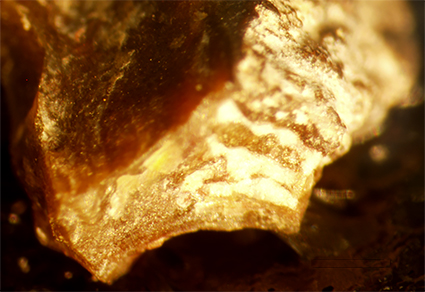Abstract
Permodontodus waurikensis n. gen. n. sp. is a small bony fish, characterized by symmetrically-placed dermal odontode pads, that inhabited Permian freshwater mudflat and seasonal pond-dominated continental lowland depositional environments in Oklahoma, USA. Lower jaw rami have been recovered from three individuals, and they present a type of dentition that appears to be previously unknown among bony fish. The broad, ridged surface of the tooth plate approaches the loxodont condition and may have functioned to scrape algae and other organisms from hard surfaces. The presence of a Meckelian groove suggests that Permodontodus waurikensis n. gen. n. sp. may have been a sarcopterygian.
References
Ahlberg, P.E., Lukševičs, E. & Mark-Kurik, E. (2000) A near-tetrapod from the Baltic Middle Devonian. Palaeontology, 43, 533–548. https://doi.org/10.1111/j.0031-0239.2000.00138.x
Aquino, A.E. & Schaefer, S. (2010) Systematics of the genus Hypoptopoma Günther, 1868 (Siluriformes, Loricariidae). Bulletin of the American Museum of Natural History, 336, 1–110. https://doi.org/10.1206/336.1
Armbruster, J.W. (2005) The loricariid catfish genus Lasiancistrus (Siluriformes) with descriptions of two new species. Neotropical Ichthyology, 3, 549–569. https://doi.org/10.1590/S1679-62252005000400013
Armbruster, J.W. & Lujan, N.K. (2022) Identification of the Oligocene to early Miocene loricariid catfish +Taubateia paraiba as a member of the Rhinelepinae. Journal of Paleontology, 96, 729–733. https://doi.org/10.1017/jpa.2021.111
Ballen, G.A. (2011) A new species of Chaetostoma tschudi (Siluriformes: Loricariidae) from Columbia with a definition of the C. anale species group. Papéis Avulsos de Zoologia, 51, 383–398. https://doi.org/10.1590/S0031-10492011002600001
Berkovitz, B. & Shellis, P. (2017) The Teeth of Non-Mammalian Vertebrates. Academic Press, London, 342 pp.
Chaplin, J.R. (2010) Stratigraphic analysis of the Permian Chase Group in Northern Oklahoma—Outcrop analogs of reservoir rocks in the Hugoton Embayment of northwestern Oklahoma and southwestern Kansas. Oklahoma Geological Survey Guidebook, 36, 1–111.
Coates, M.I., Sequeira, S.E.K., Sansom, I.J. & Smith, M.M. (1998) Spines and tissues of ancient sharks. Nature, 396, 729–730. https://doi.org/10.1038/25467
Delapieve, M.L.S., Lehmann A.P. & Reis, R.E. (2017) An appraisal of the phylogenetic relationships of Hypoptopomatini cascudinhos [sic] with description of two new genera and three new species (Siluriformes: Loricariidae). Neotropical Ichthyology, 15, e170079. https://doi.org/10.1590/1982-0224-20170079
Dunkle, D.H. (1946) A new palaeoniscoid fish from the Lower Permian of Texas. Journal of the Washington Academy of Sciences, 36, 402–409.
Giles, S., Xu, G.H., Near, T.J. & Friedman, M. (2017) Early members of ‘living fossil’ lineage imply later origin of ray-finned fishes. Nature, 549, 265–268. https://doi.org/10.1038/nature23654
Haridy, Y., Gee, B.M., Witzmann, F., Bevitt, J.J. & Reisz, R.R. (2019) Retention of fish-like odontode overgrowth in Permian tetrapod dentition supports outside-in theory of tooth origins. Biology Letters, 15, e20190514. https://doi.org/10.1098/rsbl.2019.0514
Heckert, A.B., Mitchell, J.S., Schneider, V.P. & Olsen, P.E. (2012) Diverse new microvertebrate assemblage from the Upper Triassic Cumnock Formation, Sanford Subbasin, North Carolina, USA. Journal of Paleontology, 86, 368–390. https://doi.org/10.1666/11-098.1
Huxley, T.H. (1880) On the application of the laws of evolution to the arrangement of the Vertebrata and more particularly of the Mammalia. Proceedings of the Zoological Society of London, 1880, 649–662.
Janvier, P., Clément, G. & Cloutier, R. (2007) A primitive megalichthyid fish (Sarcopterygii, Tetrapodomorpha) from the Upper Devonian of Turkey and its biogeographical implications. Geodiversitas, 29, 249–268.
Lucas, S., Cassinis, G. & Schneider, J.W. (Eds.) (2006) Non-Marine Permian Biostratigraphy and Biochronology. Geological Society of London Special Publications, London, 352 pp. https://doi.org/10.1144/GSL.SP.2006.265.01.01
Lujan, N.K. & Armbruster, J. (2012) Morphological and functional diversity of the mandible in suckermouth armored catfishes (Siluriformes: Loricariidae). Journal of Morphology, 273, 24–39. https://doi.org/10.1002/jmor.11003
Lujan, N.K., Winemiller, K.O. & Armbruster, J. (2012) Trophic diversity in the evolution and community assembly of loricariid catfishes. BMC Evolutionary Biology, 12, 124. https://doi.org/10.1186/1471-2148-12-124
MacDougall, M.J., Tabor, N., Woodhead, J. & Daoust, A.R. (2017) The unique preservational environment of the Early Permian (Cisuralian) fossiliferous cave deposit of the Richards Spur Locality, Oklahoma. Palaeogeography, Palaeoclimatology, Palaeoecology, 475, 1–11. https://doi.org/10.1016/j.palaeo.2017.02.019
McMenamin, M. (2022) First record of color and countershading in a Permian vertebrate. Academia Letters, Article 5128, 1–9. https://doi.org/10.20935/AL512
Mori, S. & Nakamura, T. (2022) Redeployment of odontode gene regulatory network underlies dermal denticle formation and evolution in suckermouth armored catfish. Scientific Reports, 12, 6172. https://doi.org/10.1038/s41598-022-10222-y
Oetking, P., Feray, D.E., Renfro, H.B. & Higginbotham, V.K. (1966) The American Association of Petroleum Geologists, United States Geological Survey. Geological Highway Map of the Mid–Continent Region. American Association of Petroleum Geologists, Tulsa, Oklahoma, 1 pp.
Olson, E.C. (1967) Early Permian vertebrates of Oklahoma. Oklahoma Geological Survey Circular, 74, 1–111.
Provenzano, F., Milani, N. & Ardila, C.R. (2017) A new species of the catfish genus Cordylancistrus (Siluriformes, Loricariidae) from the Sierra Nevada de Santa Marta, Columbia. Zootaxa, 4329, 256–266. https://doi.org/10.11646/zootaxa.4329.3.4
Reif, W.-E. (1982) Evolution of dermal skeleton and dentition in vertebrates. Evolutionary Biology, 15, 287–368. https://doi.org/10.1007/978-1-4615-6968-8_7
Reisz, R.R. (2005) Oromycter, a new caseid from the Lower Permian of Oklahoma. Journal of Vertebrate Paleontology, 25, 905–910. https://doi.org/10.1671/0272-4634(2005)025[0905:OANCFT]2.0.CO;2
Romano, C., Koot, M.B., Kogran, I., Brayard, A., Minikh, A.V., Brinkmann, W., Bucher, H. & Kriwt, J. (2014) Permian-Triassic osteichthyes (bony fishes): diversity dynamics and body size evolution. Biological Reviews, 91, 106–147. https://doi.org/10.1111/brv.12161
Rowe, D.C.T., Scott, D., Bevitt, J. & Reisz, R. (2021) Multiple tooth-rowed parareptile from the Early Permian of Oklahoma. Frontiers in Earth Science, 9, e709497. https://doi.org/10.3389/feart.2021.709497
Schindler, T. (2018) Neubeschreibung und erste Rekonstrucktion von Elonichthys germari Giebel, 1848. Hallesches Jahrbuch für Geowissenschaften, 41, 1–33.
Scholle, P.A., Peryt, T.M. & Ulmer-Scholle, D.S. (1995) The Permian of Northern Pangea. Vol. 1. Paleogeography, Paleoclimates, Stratigraphy. Springer-Verlag Berlin, Heidelberg, 261 pp. https://doi.org/10.1007/978-3-642-78593-1
Simpson, L.C. (1979) Upper Gearyan and Lower Leonardian terrestrial vertebrate faunas of Oklahoma. Oklahoma Geology Notes, 39, 3–21.
Smith, M.M. & Krupina, N.I. (2001) Conserved developmental processes constrain evolution of lungfish dentitions. Journal of Anatomy, 199, 161–168. https://doi.org/10.1046/j.1469-7580.2001.19910161.x
Spjeldnaes, N. (1967) Acanthodians from the Siluro-Devonian of Ellesmere Island. In: Oswald, D.H. (Ed.), International Symposium on the Devonian System. Vol. 2. Alberta Society of Petroleum Geologists, Calgary, Alberta, pp. 807–813.


